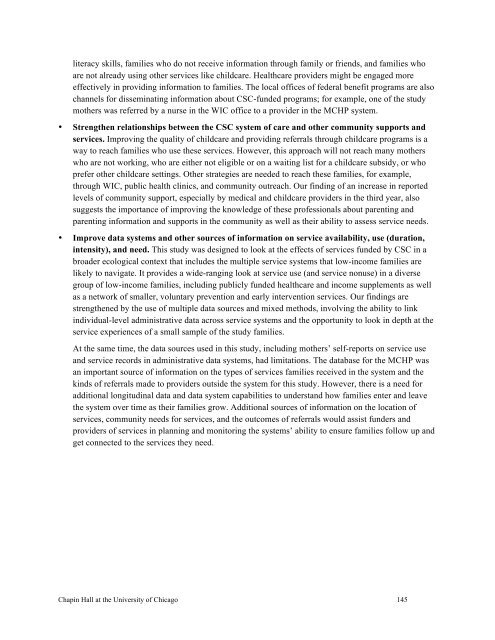2011 The Palm Beach County Family Study (Full Report)
2011 The Palm Beach County Family Study (Full Report)
2011 The Palm Beach County Family Study (Full Report)
- No tags were found...
Create successful ePaper yourself
Turn your PDF publications into a flip-book with our unique Google optimized e-Paper software.
literacy skills, families who do not receive information through family or friends, and families whoare not already using other services like childcare. Healthcare providers might be engaged moreeffectively in providing information to families. <strong>The</strong> local offices of federal benefit programs are alsochannels for disseminating information about CSC-funded programs; for example, one of the studymothers was referred by a nurse in the WIC office to a provider in the MCHP system.• Strengthen relationships between the CSC system of care and other community supports andservices. Improving the quality of childcare and providing referrals through childcare programs is away to reach families who use these services. However, this approach will not reach many motherswho are not working, who are either not eligible or on a waiting list for a childcare subsidy, or whoprefer other childcare settings. Other strategies are needed to reach these families, for example,through WIC, public health clinics, and community outreach. Our finding of an increase in reportedlevels of community support, especially by medical and childcare providers in the third year, alsosuggests the importance of improving the knowledge of these professionals about parenting andparenting information and supports in the community as well as their ability to assess service needs.• Improve data systems and other sources of information on service availability, use (duration,intensity), and need. This study was designed to look at the effects of services funded by CSC in abroader ecological context that includes the multiple service systems that low-income families arelikely to navigate. It provides a wide-ranging look at service use (and service nonuse) in a diversegroup of low-income families, including publicly funded healthcare and income supplements as wellas a network of smaller, voluntary prevention and early intervention services. Our findings arestrengthened by the use of multiple data sources and mixed methods, involving the ability to linkindividual-level administrative data across service systems and the opportunity to look in depth at theservice experiences of a small sample of the study families.At the same time, the data sources used in this study, including mothers’ self-reports on service useand service records in administrative data systems, had limitations. <strong>The</strong> database for the MCHP wasan important source of information on the types of services families received in the system and thekinds of referrals made to providers outside the system for this study. However, there is a need foradditional longitudinal data and data system capabilities to understand how families enter and leavethe system over time as their families grow. Additional sources of information on the location ofservices, community needs for services, and the outcomes of referrals would assist funders andproviders of services in planning and monitoring the systems’ ability to ensure families follow up andget connected to the services they need.Chapin Hall at the University of Chicago 145
















